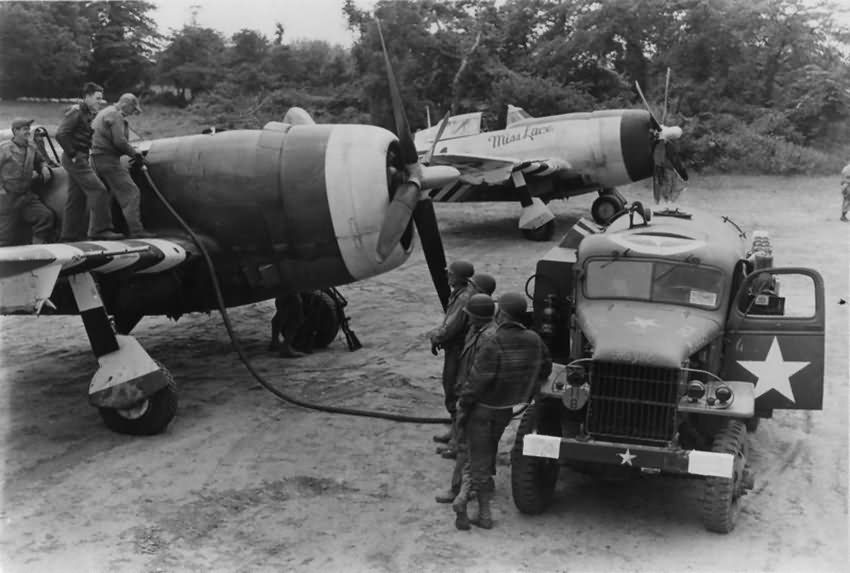The 48th Fighter Group (48th FG)
Early History and Deployment to Europe
- Initial Operations: The 48th Fighter-Bomber Group originally operated aircraft such as the P-39 Airacobra and P-40 Warhawk while based in the United States.
- Move to England: In March 1944, the group was transferred to England. Upon arrival, it converted to the P-47 Thunderbolt, a versatile and powerful fighter-bomber.
- Redesignation: In May 1944, the group was redesignated as the 48th Fighter Group (48th FG).
Operations in Support of D-Day and Beyond
- First Combat Missions: The 48th FG began combat operations on April 20, 1944, with a sweep over the French coast.
- Pre-D-Day Operations: The group flew escort and dive-bombing sorties in preparation for the D-Day invasion, targeting bridges, gun emplacements, trains, road transport, and fuel dumps to disrupt German defenses and logistics.
- D-Day Contributions: On June 6, 1944, the group was actively involved in the D-Day invasion, providing crucial air support to the Allied forces landing in Normandy.
Post-D-Day and the Drive Across France
- Move to Normandy: On June 18, 1944, the 48th FG relocated to Normandy, following the Allied ground forces as they advanced across France.
- Supporting the Allied Advance: The group continued to provide close air support, attacking enemy positions and infrastructure. It also participated in the Allied assault on Holland in September 1944.
- Belgian Operations: At the end of September 1944, the group moved to Belgium. During the autumn of 1944, the group’s effective operations led to it being awarded two Belgian citations in recognition of its contributions.
Distinguished Unit Citation and the Battle of the Bulge
- DUC Award: In December 1944, the 48th FG was awarded a Distinguished Unit Citation (DUC) for its bravery and effectiveness in the face of intense enemy resistance at a stronghold in Belgium.
- Battle of the Bulge: The group played a critical role during the Battle of the Bulge, the last major German offensive on the Western Front, providing air support to Allied ground troops during December 1944 and January 1945.
Final Operations and Return to the USA
- Weather Reconnaissance and Special Missions: In addition to its tactical operations, the group conducted weather reconnaissance flights. On one notable occasion, blood plasma was delivered to ground troops using belly tanks.
- VE-Day and Aftermath: The 48th FG continued its operations until Victory in Europe (VE) Day in May 1945. After the war, the group returned to the United States in August and September 1945.
Key Units and Bases
Squadrons:
- 492nd Fighter Squadron (FS): Code [F4]
- 493rd Fighter Squadron (FS): Code [I7]
- 494th Fighter Squadron (FS): Code [6M]
Bases of Operation:
- Ibsley, England: (March 29, 1944)
- Deux Jumeaux, France: (June 18, 1944)
- Villacoublay, France: (August 29, 1944)
- Cambrai/Niergnies, France: (September 15, 1944)
- St. Trond, Belgium: (September 30, 1944)
- Kelz, Germany: (March 26, 1945)
- Kassel, Germany: (April 17, 1945)
- Illesheim, Germany: (April 29, 1945)
- Laon, France: (July 5, 1945 – August 1945)
Commanding Officers
- Col. Dixon M. Allison
- Col. George L. Wertenbaker Jr. (April 23, 1944)
- Col. James K. Johnson (October 1944)
- Lt. Col. Harold L. McNeely (June 8, 1945)
- Lt. Col. Paul P. Douglas Jr. (June 28, 1945)
Aircraft and Markings
- Aircraft: The group operated the P-47 Thunderbolt throughout its service in Europe.
- Squadron Markings:
- 492nd FS: Red rudder and front of cowling.
- 493rd FS: Blue rudder and front of cowling.
- 494th FS: Yellow rudder and front of cowling.
- All Squadrons: Red and white chequered cowling.
